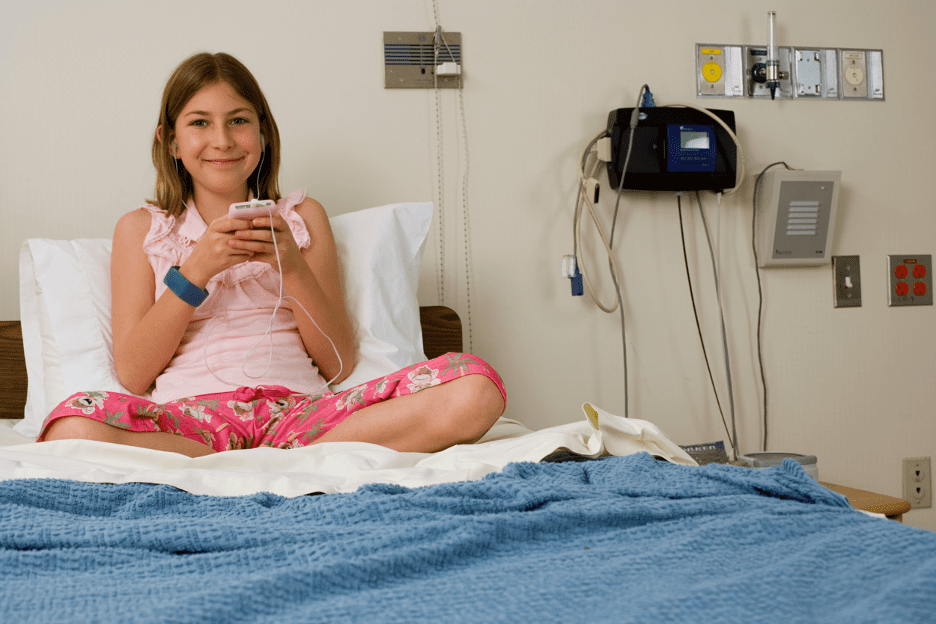In the days before COVID-19, the day-to-day hospital patient experience was filled with plenty of opportunities to stay socially engaged, stimulated, and distracted.
Family members could spend time with patients. Friends could drop in and say hello. Even patients’ interactions with nursing staff could be more frequent. Such connections helped to prevent loneliness or isolation. And according to John Hopkins Medicine, they improved a patient’s overall positivity, comfort, outlook and recovery–helping reduce the risk of readmission
Now, the world has changed. The way we consider patient entertainment is changing with it.
As such interpersonal connections likely will be limited for some time to come, hospitals have an opportunity to leverage digital tools to help fill that gap.
HOSPITAL STAYS IN THE COVID-19 ERA CAN BE FRIGHTENING FOR PATIENTS
In the COVID-19 era, the patient experience is very different, to say the least.
In many cases, there are no visitors allowed. Human interaction is limited. Physical contact is minimized. Patients must take extra caution to self-isolate.
Even when patients receive treatment from the physician or medical staff, it might feel impersonal-particularly when doctors, nurses, and other healthcare workers are wearing full PPE gear, which tends to unsettle patients.
When patients are isolated, it can be discouraging (no one likes to be lonely). It’s all too easy for them to become disheartened about their situation. And, as studies have shown, a lack of social connection can impact a person’s health, wellbeing and physical recovery.
So, what are some strategic approaches hospital staff can take to purposefully combat the loneliness and boredom of patient isolation?
It all starts with a modern hospital patient entertainment system… although it goes far beyond just the TV.
PATIENT ENTERTAINMENT HAS EVOLVED
When Sentrics first introduced the concept of patient room televisions in the late 1980s, the idea was no less than revolutionary. Many hospitals still rely on those very outdated TV systems and equipment even as technological capabilities have rapidly evolved over the past decade and a half. As a result, hospitals’ old legacy systems have become outdated, costly to maintain and insufficient to meet the demands of today’s consumer-patients. Common issues include:
- Traditional patient TVs offer minimal functionality
- Analog TVs lack internet capability
- Outdated hardware and wiring lead to excessive service calls, maintenance staff time to fix, and TV downtime that makes for unhappy patients
Put simply, these old systems are not enough. Patients’ needs and expectations have changed.
In 2020, patients demand the same level of entertainment capabilities as they enjoy in their everyday life. Today’s consumers are used to 24/7 access to streaming services, movies on demand and social media – the type of features possible on smart TVs.
Patients want that same level of entertainment while in the hospital.
IT’S TIME TO UPGRADE TO AN INTERACTIVE PATIENT ENGAGEMENT SYSTEM
Want to keep your patients entertained and distracted?
Making the switch to a hospital-grade smart TV equipped with interactive patient engagement capabilities has a host of benefits, including:
- Improving the hospital experience through entertainment – A long-term stay in the hospital is a recipe for boredom. Long hours in a bed alone leaves a patient with plenty of empty time on their hands. TV, movies and games help break up the monotony. They have the power to make a patient smile or laugh, and that alone helps speed healing.
Today, patients expect more entertainment options from the hospital staff.
Consumer-patients expect an entertainment package that at least includes:
○ High-quality television broadcast
○ Movies
○ Games, puzzles, and brain teasers
- Distracting patients to keep them comfortable – Aside from traditional TV viewing, patient entertainment systems can keep them engaged and relaxed. Today’s smart TVs enable the hospital to deliver a wide range of in-bed activities including:
○ Scientifically-designed music therapy
○ Ambient noise reduction
○ Virtual visits (pet therapy, for instance)
○ In-bed therapy and exercise
- Health education videos
Related: The Importance of Noise Reduction in Patient Healing and Satisfaction
- Helping patients connect – If patients’ in-person interactions are limited, then they must have alternative ways to connect and communicate with friends, family and the outside world. The more ways individuals have to socialize, the better.
Today, this can be accomplished without a patient ever leaving their bed. All of these entertainment capabilities can come at the click of a button.
Upgrading to modern systems is the key to beating patient boredom and getting them more engaged in their treatment. A Samsung study found that hospitals which use a patient entertainment system reported better patient satisfaction and health outcomes, and decreased hospital readmissions.
AN INTERACTIVE ENTERTAINMENT SOLUTION
In an unprecedented period like this, patients lack the ability to engage in meaningful social connections during their hospital stay. This forced boredom and isolation can have significant ramifications on their health and continued recovery.
To prevent the detrimental consequences of social isolation, hospitals must seek out new ways to entertain and distract with a modern patient entertainment system.
This is where Sentrics’ E3 Patient Engagement platform can help.
Our mission is to transform the patient room into an interactive learning and entertainment environment that keeps patients engaged, entertained, and informed. With an integrated solution like Sentrics, you can improve patient satisfaction.
Interested in seeing what Sentrics can do for your patients? Contact us to find out more.
Sources:
John Hopkins Medicine. The Power of Positive Thinking. https://www.hopkinsmedicine.org/health/wellness-and-prevention/the-power-of-positive-thinking
NPR Hospital Visitor Bans Under Scrutiny After Disability Groups Raise Concerns Over Care.https://www.npr.org/2020/05/17/857531789/federal-government-asked-to-tell-hospitals-modify-visit-bans
Nursing Times. Nurses worry patients ‘fear them more’ when wearing mask.
NCBI. Maintenance and Development of Social Connection by People with Long-term Conditions: A Qualitative Study. https://www.ncbi.nlm.nih.gov/pmc/articles/PMC6603716/
The Guardian. By 2005 hospitals must offer online bedside services and electronic records, providing openings for private firms. https://www.theguardian.com/business/2002/sep/17/NHS.broadcasting
Samsung. How Patient Entertainment Systems Boost Satisfaction and Health Outcomes.https://insights.samsung.com/2016/04/29/how-patient-entertainment-systems-boost-satisfaction-and-health-outcomes/



